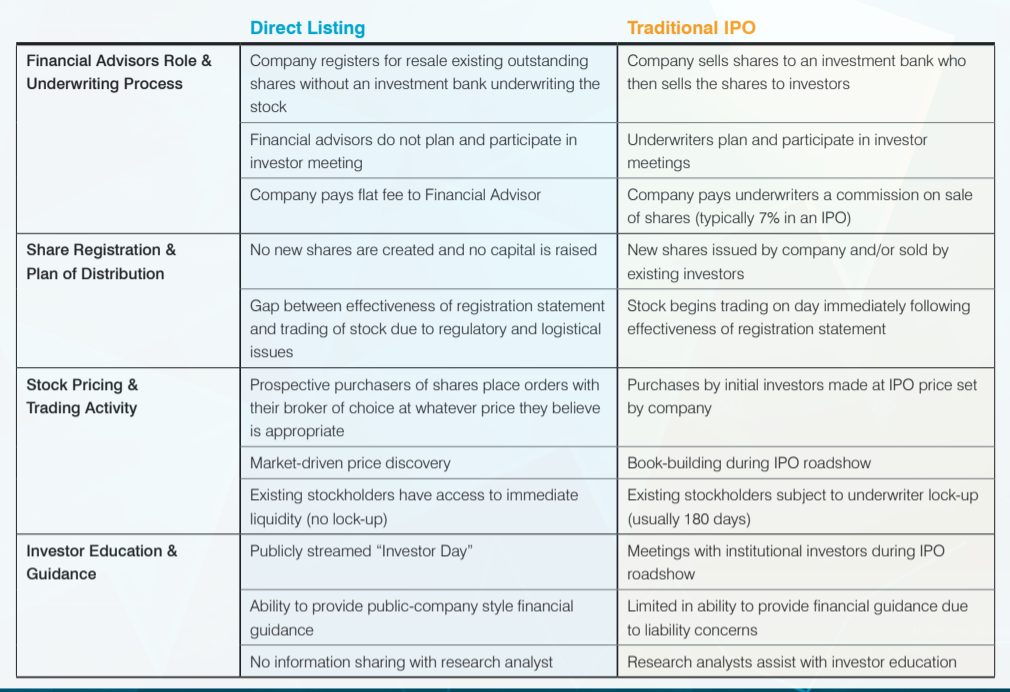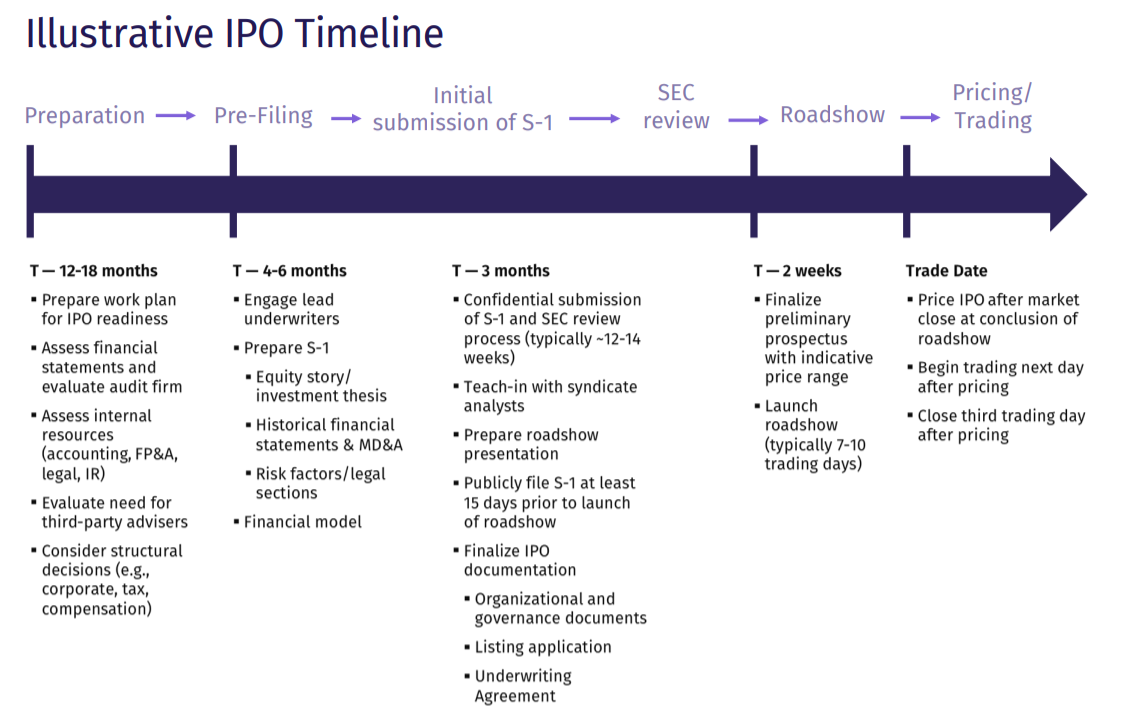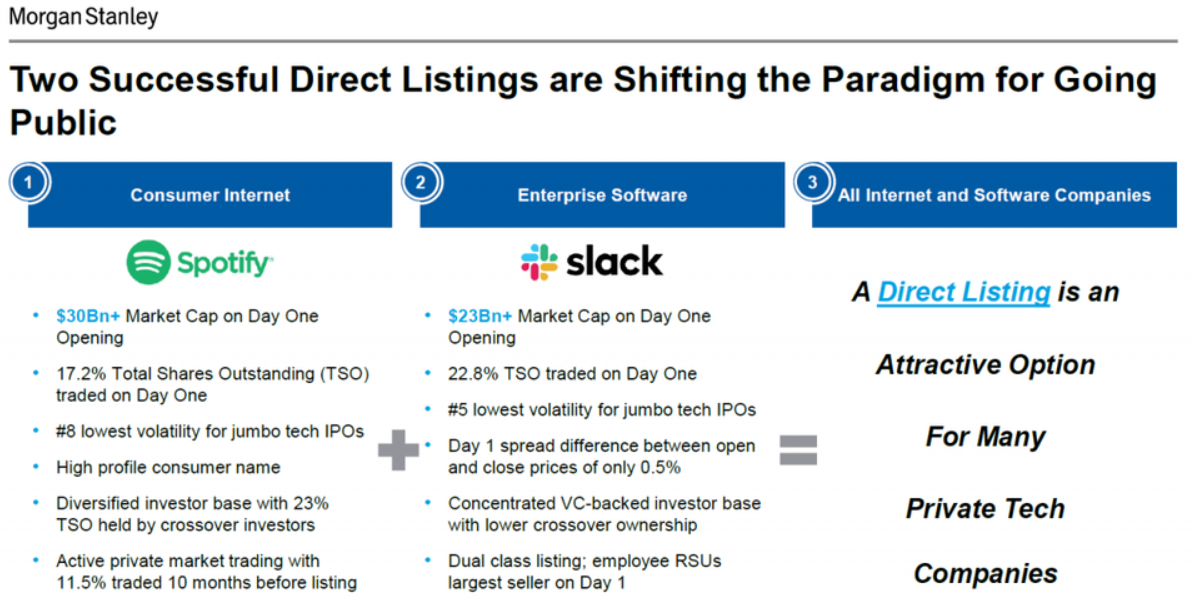Direct listing VS IPO: which is the better choice for your venture backed startup company?
(image credit:WSJ)
The well known venture capital firm Andreessen Horowitz explains in an article that startups which are truly interested in building a sustainable and long term business, go through a number of strategic financing milestones along their lifecycle. From mindsets that help to successfully raise investment funding rounds to when and how to build a finance function with a CFO to what it takes to do an initial public offering (IPO). They also explain that there is a lot that goes on behind the scenes on the road to IPO, including how they’re priced, that may affect building your company.
An interesting effect of the boom in US stocks is that a growing number of founders, CEOs and executives are considering whether doing a traditional IPO is the right move to give early investors liquidity. There is an emerging trend that is now getting more attention with a few technology companies choosing to do a ‘Direct Listing’ instead of a traditional IPO as a route to the public markets of the NYSE. There are several reasons for this, ranging from regulatory changes to old hangups about investment-banking fees. Spotify started this trend in 2018, and Slack did it the summer of 2019. Morgan Stanley who advised both companies wrote about it from a bankers perspective. Both of these companies debuted on the New York Stock Exchange (NYSE), and so had all the outward trappings of an IPO, from ringing the bell to a specialist on the floor of the NYSE opening the stock for trading.
Peter Cohan recently wrote an article on INC titled “Why a direct listing could better than an IPO” where he explains that if you are a well known private company with a sticky product or a strong brand following that has already attracted a lot of capital then a direct listing could be a better option. But if your venture backed startup is not already well known then a more traditional and costlier (investment banking fees) IPO might help to raise demand from investors in the “roadshow” for buying your company’s shares. According to an article in Quartz, Palantir, the big data-mining firm backed by Peter Thiel is planning a direct stock listing later this month. So let’s dive into the pros and cons of each process.
 (Image credit: Fenwick & West LLP)
(Image credit: Fenwick & West LLP)
Traditional IPO: Pros and Cons
In a traditional IPO, the startup gives up control of the process to an investment bank, such as Mrogan Stanley, JP Morgan, or Goldman Sachs. The investment bank is supposed to help create appetite for the shares by hosting so-called roadshows in which management makes the pitch for buying shares offered in front of the bank’s favored clients (such as mutual funds and institutional money managers). According to the Andreessen Horowitz article, in a traditional IPO, the company going public literally goes “on the road” with their underwriter (the investment bank) over an intense two-week period for back-to-back, intimate meetings with potential investors. They do this not just to market their company story, but to enable the management team to build relationships with investors — typically, large institutional investors — and for those investors to then submit orders to purchase shares (“building the book”) at the end of the process.
Meaning in this traditional IPO process, a venture backed startup, raises money and creates a public market for its shares by selling newly created stock to investors. As a Techcrunch contributor, Jamie Evans wrote in an article “in some instances, a select number of pre-IPO investors, usually very large stockholders or management, may also sell a portion of their holdings in the IPO.” In the regular IPO, the company engages investment bankers to help promote, price and sell the stock to investors. With an IPO the investment bank will gauge the demand for the shares right before the IPO and sets the price range for the opening listing day. Furthermore, when the shares start trading, the bank monitors the stock price. If demand for the stock is weak, the bank buys the shares in a bid to make sure that the company’s stock closes above its offering price. Mr Cohan explains in his article that usually, the bank sets the initial trading price of the stock below where it expects the price to end the daysells those lower priced shares to its favored clients. The investment bankers are paid a commission for their work that is based on the size of the IPO—usually 7 percent for a traditional technology company IPO. Now the investment banks justify this by pointing out that if the shares of the company rise significantly on the day of the IPO, it will create more demand for the shares from investors who missed out on the previous day’s trading. While that could happen, two other outcomes are nearly certain. The bank’s favored clients will enjoy a risk-free first-day IPO trading pop when the shares become available later to the general public. And the first-day pop costs the share-issuing company capital that it would have raised were its offering price set at a higher level.

(image credit: Donnelley Financial Solutions)
When compared to a direct listing, An IPO is more expensive, as mentioned that investment banks charge underwriting fees that range from 7 percent of capital if you raise less than $100 million down to 3.5 percent for offerings exceeding $1 billion, according to PWC. The process for taking a private company public, can be lengthy and costly, but the potential rewards make it worthwhile for many organizations. Recently PriceWaterhouseCoopers published an IPO readiness test article titled “Considering an IPO: first understand the costs” stated in a corporate CEO survey that:
“Executives at 98% of companies that recently completed an IPO said they wished that they had used a more formal IPO assessment process and framework. Taking a cross-functional view of readiness—beyond accounting, financial reporting and legal matters—is essential. A holistic IPO readiness framework identifies critical functional areas that may need to be assessed, created or enhanced by organizations prior to becoming a public company.”
And while the bank underwriting fee can be the largest direct cost that a company incurs as it prepares to IPO, the legal, accounting and tax costs are also consequential and can increase significantly for companies facing additional complexities in preparing for an IPO. PWC article says the categories of different costs that are ultimately disclosed in a company’s IPO prospectus include underwriting, legal, accounting, printing, registration with the US Securities and Exchange Commission (SEC), filing with Financial Regulatory Authority (FINRA), exchange listing and other miscellaneous costs directly attributable to the offering.
Regardless of the fees, Mt Cohan states “to be sure, the IPO remains popular. It offers experienced guidance to founders who have not done IPOs in the past, it raises new capital for the company, and it makes the public more aware of the company.” He also points out “in addition, if the stock price drops on the first day, the bank’s role as a “stabilization agent” could be vital for the company, noted the WSJ.”
Direct Listings: Pros and Cons

(Image credit: MORGAN STANLEY)
The direct listings method is also an attractive alternative for some issuers. There’s no roadshow, the fees are lower, and the offering price gets set on an exchange, not by investment bankers. Spotify, the streaming music service, pioneered direct listings in 2018, and messaging service Slack followed in 2019, with Goldman Sachs playing a key role in both deals. When Spotify opted for a direct listing, rather than issue new shares, the company started trading by letting existing shareholders sell their shares directly on the public market. It also meant Spotify didn’t raise a cent–all the proceeds went directly to the selling shareholders, such as early investors and employees. And unlike an IPO, in a direct listing, a company does not sell stock directly to investors and does not receive any new capital. Instead, it facilitates the re-sale of shares held by company insiders such as employees, executives and pre-IPO investors. Investors in a direct listing buy shares directly from these company insiders. So early investors, employees and founders can cashout on some of their shares.
Despite the buzz around this kind of fundraising, there hasn’t been a direct listing in more than a year—but that’s likely to change soon. In addition to Palantir, the corporate-software maker Asana (founded by a former Facebook co-founder) is planning a direct listing, and plans to join Spotify and Slack on the New York Stock Exchange.
A direct listing allows private companies to sell shares to the public without intermediaries. The company makes a certain number of shares available for members of the investing public to purchase at a price set by a negotiation between the buyer and the company, according to Stanford Law School. Once the shares are sold, the company’s fluctuating stock price becomes available to anyone who wants to buy or sell it.
No lockup period. According to reporting from Bloomberg, Palantir, is choosing the direct listing alternative, because it would allow the company’s current investors to sell their shares on the first day of trading rather than having to wait for a 6 month lock-up period to expire, as would be required in a traditional initial public offering. Unlike an IPO, though, the company doesn’t raise capital in a direct listing. Which means the biggest difference between an IPO and a Direct Listing is that there is no “o” — that is, there is no offering from the company selling its stock to public investors.
Does it mean that investment bankers and advisors are no longer needed by startups when doing a direct listing? According to the Techcrunch article, companies still engage investment banks to assist with a direct listing and those banks still get paid quite well (to the tune of $35 million in Spotify and $22 million in Slack). The banks act as advisors and are prohibited under current law from organizing or attending investor meetings and they do not sell stock to investors. Instead, they act purely in an advisory capacity helping a company to position its story to investors, draft its IPO disclosures, educate a company’s insiders on process and strategize on investor outreach and liquidity.
Of course, planning, investor education, and relationship building matters in a Direct Listing, too — only here the roadshow is replaced by an “Investor Day”, where the company invites investors to learn about them one-to-many, including via a webcast. In this way, Direct Listings can be considered more democratic because everyone has access to the same information all at once.
According to the Techcrunch article, direct listings are not a totally new concept. Companies in a variety of industries have used similar structures for years. A Forbes contributor in an article titled “direct listings: an alternative to the IPO” stated that historically, smaller companies such as food and biotech have gone public via a direct listing.So what has changed is when the two famous companies of Spotify and Slack used it, it brought new attention from the media and investors to the direct listing option. What is the reason that some large venture funded startups are choosing this method. A couple of things.
The rise of massive pre-IPO fundraising rounds
With an abundance of investor capital, especially from institutional investors that historically hadn’t invested in private technology companies, massive pre-IPO fundraising rounds have become the norm. Slack raised over $400 million in August 2018—just over a year prior to its direct listing. Because of this widespread availability of capital, some technology companies are now able to raise sufficient capital before their actual IPO to either become profitable or put them on a path to profitability.
Criticism of current IPO process
There has been increasing negative commentary, especially amongst well-known venture capitalists, about certain aspects of the traditional IPO process—namely IPO lock-up agreements and the pricing and allocation process.
IPO lock-up agreements. As briefly mentioned above, in a traditional IPO, investment bankers require pre-IPO investors, employees and the company to sign a “lock-up agreement” restricting them from selling or distributing shares for a specified period of time following the IPO—usually 180 days. The bankers put these agreements in place in order to stabilize the stock immediately after the IPO. While the merits of a lock-up agreement can certainly be debated, by the time VCs (and other insiders) are allowed to sell following an IPO, oftentimes the stock price has fallen significantly from its highs (sometimes to below the IPO price) or the post lock-up flood of selling can have an immediate negative impact on the trading price.
While the pros of going the direct listing avenue are pretty straight forward, It can provide liquidity to its investors — which include capital providers and some of its employees — without paying millions of dollars in fees to an investment bank. Without an intermediary, however, there is no safety net ensuring the shares sell. There is no lock-up agreement, which allows for equal access to the offering to all of the company’s pre-IPO investors, including rank-and-file employees and smaller pre-IPO stockholders. To put in perspective the fees of some recent direct listing which are less than traditional IPOs.
- Spotify did its direct listing at a $29 billion market capitalization and paid $35 million in advisory fees
- Snap went public in IPO at a $24 billion market capitalization and paid $85 million in underwriting fees
In an INC article about Spotify’s CFO Barry Mccarthy, and his take on the process. He said another benefit of having no underwriters? Because you’re not issuing a percentage of shares to the banks, existing shareholders won’t experience dilution when you start trading.
While the cons of a direct listing could be significant or irrelevant depending on your company. To be sure, if you do a direct listing or an IPO, you will need to pay lawyers and accountants among other professionals to help you produce a prospectus for the shares you’re selling. And in both cases you will need to produce quarterly financial statements and talk with investors and the media about them every quarter.
If your company is well known by the public and you do not need to raise new capital to keep your business afloat, a direct listing may be a good route with few disadvantages. Spotify was, in many ways, the perfect test case for a direct listing. It was well known, didn’t need any additional capital and was cash flow positive. But not all companies are generating positive cash flow, look at Uber.
However, if your company is not well known and it does need to raise new capital, then a direct listing may not be right. A direct listing will not help create demand for the stock of a less well-known company, nor will it enable the company to raise new capital.

(image credit: NYSE)
The U.S. Securities and Exchange Commission issued an order on Wednesday August 26th, approving the New York Stock Exchange’s request to let companies raise capital through direct listings, which is often a less expensive alternative to an initial public offering. Previously companies could only use the direct listing process to let existing investors sell shares; now a company can let existing investors sell their shares while simultaneously selling newly issued shares to the public.
Conclusion
it’s good for a company to have both options. Pick the one or the combination of the two that best meets your company’s needs. According to CNBC, just last week a video game software platform that allows developers to build their own games called Unity hit the public markets with a virtual IPO event that allowed employees to sell some of their shares on the company’s first day of trading, rather than waiting for the 180-day lockup period to expire. Unity said in its latest prospectus that employees and former employees, excluding executive officers and directors, can sell up to 15% of their vested holdings from the time the stock opens on the New York Stock Exchange through Sept. 30. Since the traditional IPO process is under so much scrutiny, (as a way for investment banks to get hot IPO shares to their preferred investors). And Unity took a different approach, with CFO Kimberly Jabal and CEO John Riccitiello having potential investors submit bids through a platform that would allow them to choose the price and allocation, rather than leaving it to bankers. Unity’s CEO said “it was important to bring the company’s 3,700 employees into the IPO by letting them all virtually ring the bell together on Friday and to sell some shares on the first day.”
If you are thinking about taking your company public within the next year or two, it is advised that you access your organization and its processes, systems and overall preparedness to operate as a public company.









